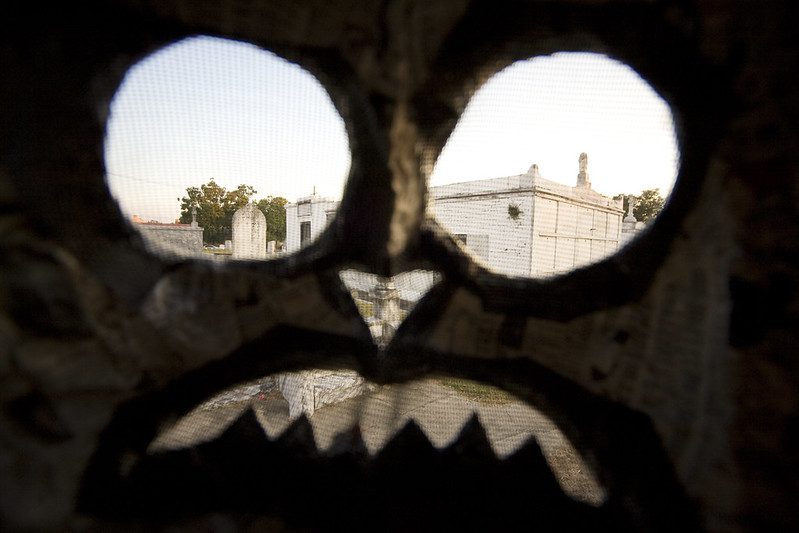 Technology
Technology  Technology
Technology  Humans
Humans 10 Everyday Human Behaviors That Are Actually Survival Instincts
 Animals
Animals 10 Animals That Humiliated and Harmed Historical Leaders
 History
History 10 Most Influential Protests in Modern History
 Creepy
Creepy 10 More Representations of Death from Myth, Legend, and Folktale
 Technology
Technology 10 Scientific Breakthroughs of 2025 That’ll Change Everything
 Our World
Our World 10 Ways Icelandic Culture Makes Other Countries Look Boring
 Misconceptions
Misconceptions 10 Common Misconceptions About the Victorian Era
 Mysteries
Mysteries 10 Strange Unexplained Mysteries of 2025
 Miscellaneous
Miscellaneous 10 of History’s Most Bell-Ringing Finishing Moves
 Technology
Technology Top 10 Everyday Tech Buzzwords That Hide a Darker Past
 Humans
Humans 10 Everyday Human Behaviors That Are Actually Survival Instincts
 Animals
Animals 10 Animals That Humiliated and Harmed Historical Leaders
Who's Behind Listverse?

Jamie Frater
Head Editor
Jamie founded Listverse due to an insatiable desire to share fascinating, obscure, and bizarre facts. He has been a guest speaker on numerous national radio and television stations and is a five time published author.
More About Us History
History 10 Most Influential Protests in Modern History
 Creepy
Creepy 10 More Representations of Death from Myth, Legend, and Folktale
 Technology
Technology 10 Scientific Breakthroughs of 2025 That’ll Change Everything
 Our World
Our World 10 Ways Icelandic Culture Makes Other Countries Look Boring
 Misconceptions
Misconceptions 10 Common Misconceptions About the Victorian Era
 Mysteries
Mysteries 10 Strange Unexplained Mysteries of 2025
 Miscellaneous
Miscellaneous 10 of History’s Most Bell-Ringing Finishing Moves
Top 10 Brutal Unsolved Halloween Murders
Murder is a sad fact of life. It happens every day of the year, and it’s always tragic. All the same, homicides committed on Halloween tend to be more striking, especially when the perpetrator remains unidentified and the crime unsolved. Halloween and horror may go hand-in-hand, but the horror is supposed to be inconsequential, a brief engagement with dread followed by the safety and security of home. That was not the case for the following ten victims, all of whom were murdered on October 31 or after leaving Halloween celebrations. As of this writing, their deaths remain unsolved.
SEE ALSO: 10 Sinister Halloween Horror Stories That Really Happened
10 The Murder Of Roland DeLoatch And Joseph Smith

A family’s life was turned upside down on Halloween night in 2016. Roland DeLoatch, 41, and Joseph Smith, 28, resided in Sanford, Florida, and cared for their mother, Barbara, who lived with them. Joseph, an aspiring rapper, was two weeks away from releasing an album.
At around 9:00 PM, an unidentified assailant wearing a mask entered the brothers’ home. The masked intruder promptly shot Joseph. Roland, who’d just returned from work, heard the shot and ran to his family’s aid. The gunman simply shot him next. Barbara, witness to her sons’ murder, was spared, though the intruder made her drop to her knees and beg for her life. Joseph died in the house; Roland died in a nearby hospital. No one knew who’d killed the brothers.
A promising development appeared to emerge on November 11. That day, the Sanford police named a man called Dante James as a person of interest. The day after Halloween, James, along with his girlfriend Sawbeta Seal (also reported as “Shawbetta Seals”), had been arrested on weapons charges. They were released on bond, after which James cut his GPS anklet and fled. He was arrested on November 22. Investigators determined that James couldn’t have been the murderer, but he and Seal were believed to have information about the killings. However, they wouldn’t cooperate with the police. Similarly, Joseph’s girlfriend is believed to know something about the incident, but she wouldn’t cooperate, either. Despite a $5,000 reward for any information on the murders, the killer remains at large.
9 The Murder Of Sylvia Salinas

On October 31, 1989, 30-year-old Sylvia Salinas was working at her small corner grocery store in Galveston, Texas. She was certainly aware of the possibility of her business being robbed; she kept both a machete and a pistol below the cash register. Whoever came into the store that day must not have sent up any red flags, for Sylvia touched neither. Perhaps it was someone she knew. Regardless, this unidentified person stabbed Sylvia in the heart, ending her life.
There were no indications that Sylvia made any attempt to fight back, and she did not trigger the silent alarm. The murderer did that himself when he pried the register open to take the cash inside. He fled, leaving the knife at the scene, before the police arrived. They cordoned off the area and began to collect evidence. Despite their efforts and the interviewing of around 20 suspects, investigators never found Sylvia’s killer. To make matters worse, the cold case became all the more so in 2008, after much of the evidence was lost to Hurricane Ike.
In 2018, however, the case received renewed attention when reports hit the news that a critical piece of evidence had, in fact, survived: a videotape made by police of the crime scene soon after Sylvia was murdered. It shows the crime scene in detail, including both the murder weapon and footprints left by the killer, and now stands as the best hope for solving the murder. Some fingerprints were preserved as well.
8 The Murder Of Anthony Seabell

Halloween night in 2013 was a violent one in New York City. Three men were shot to death in Brooklyn, and two others suffered nonfatal gunshot wounds in Queens. One of the Brooklyn killings received a bit more attention than the others: that of Anthony Seabell
At around 8:30 PM, Anthony, age 19, was walking on East 31st Street in the Farragut neighborhood when a man wearing a Ghostface mask, immediately recognizable from the Scream movies, fired upon him. A bullet struck Anthony in the head, and the Ghostface-masked perpetrator ran off. Anthony was taken to Kings County Hospital, where he died.
Despite initial media attention due to the murderer dressing as a horror movie villain, there was little subsequent reporting on the case. The identity of the man in the Scream mask has yet to be determined.
7 The Murder Of Derek Grain

At the end of October 1980, Derek Grain had spent two months in Bristol, England, temporarily working for British Aerospace in nearby Filton. Though he was known to enjoy quite a few drinks when he’d go out on the town, Derek wasn’t noted for being quarrelsome or prone to participating in bar fights. That fact made his fate all the more shocking to those who knew him.
On the evening of October 30, Derek went to two nightclubs, first Vicki’s and then Curves, both of which were on Park Street. At around 2:00 AM on October 31, he left Curves, presumably to return to his room at the Unicorn Hotel. However, he chose to walk down Brandon Hill Lane, a move which would later perplex detectives. Whatever his intentions, Derek never returned to the hotel. Later that morning, a nurse discovered him dead in a pool of his own blood on Brandon Hill, lying facedown. A sand-filled traffic cone was found 240 feet (73 m) away. Derek had been beaten to death with this unusual murder weapon, and the attacker or attackers appear to have repeatedly kicked his body as it lay on the ground.
The motive was believed to have been robbery. Derek’s bank cards were scattered around the crime scene, and between £50 and £60 had been stolen from his pockets. It’s possible that the murderer(s) saw Derek dropping large amounts of cash at the clubs and followed him. Aside from the murder weapon, another clue was present in the form of a bloody footprint on the back of Derek’s shirt.
Leads soon surfaced. Several witnesses came forward to describe three or four men attacking a lone victim near Clifton Hill at around 3:00 AM. A red Jaguar sports car, not normally seen in the area, was also reported to have been around. However, the leads didn’t pan out, and advances in forensics over the years haven’t managed to shed any more light on the murder. Analysis of the traffic cone has provided little useful information. In 2009, the pockets of Derek’s clothes were scoured in the hope of finding DNA left by whoever killed him, but this, too, proved fruitless. The case remains unsolved.
6 The Murder Of Norton Gregory

Kirkland, Washington, was a quiet place in the 1950s. On a road to nearby Redmond, which today is the much busier Northeast 70th Street, stood a small gas station and convenience store. It had been opened by Norton Gregory in 1952. Norton lived a few blocks away with his wife, Helen, and their six children.
On October 31, 1957, a customer, Mrs. O’Farrell, entered the store to find Norton lying on the floor. He had been shot in the head five times. Amazingly, he was still clinging to life at that point, though he would ultimately succumb to his wounds. Mrs. O’Farrell called the King County Sheriff’s Office, and officers soon arrived. She never set foot in the store again.
The coroner later found that of the five gunshots Norton took, three were fired from close range. It was speculated that perhaps he had come across someone stealing money from the cash register, and the thief panicked and started shooting. Rumors flew about people with grudges or that Norton had gambling debts, but these were never substantiated. To the amazement of many, Helen reopened the store only a few weeks after Norton’s death and ran it herself. She later married a sheriff’s deputy.
In 1958, it seemed for a time that the case was going to be solved. A teenager confessed to killing Norton and told authorities where the murder weapon could be found. However, it turned out that the boy had been a patient at Western State Hospital on the day of the murder. The case has gone quite cold since then; the most recent notes in the file are from 1966. It is entirely possible that Norton’s killer is now dead.
5 The Murder Of Arpana Jinaga

Arpana Jinaga was an amazing young woman. The 24-year-old software engineer had graduated from Rutgers and worked for a company in Bellevue, Washington. Her interests outside of work included motorcycles and Tae Kwon Do, and she also volunteered at both a fire department and an animal shelter. By all accounts, Arpana greatly enjoyed her life and was well-liked.
During the first weekend of November 2008, however, Arpana’s father became worried. She hadn’t answered several phone calls. On Monday, a friend of his went to her apartment in Redmond check on her, accompanied by Arpana’s next-door neighbor. They discovered that the door to her apartment had been forced open. Arpana’s nude body was found on the floor of her bedroom. She had been beaten severely, gagged with duct tape, and, in all likelihood, raped. The apparent murder weapon was a nearby boot lace, which had been used to strangle her. Arpana’s killer had taken steps to destroy evidence. Motor oil had been poured over her body and other items, and her hands were slathered with toilet-bowl cleaner. The linens had been removed from her bed; the comforter was found soaking in the bathtub, and another blanket had been partially burned.
How had this happened? On Halloween, Arpana and others in her apartment building had thrown a combined Halloween party, spread across several units. She was last seen alive at around 3:00 AM the next morning, when she left an apartment on the ground floor and went to her own, on the third floor. Afterward, her neighbors heard “muffled moaning sounds,” but they took the noise to be indicative of consensual sex. It wasn’t. It is believed that Arpana was murdered at around 8:00 AM. She wasn’t found until November 3.
Despite the killer’s attempts to destroy evidence, DNA was recovered from the crime scene. The problem was that it belonged to three different people. The boot lace had DNA from a man who had an alibi. DNA belonging to a man named Emanuel Fair, a convicted sex offender who raped a 14-year-old girl in 2004, was on Arpana’s neck as well as the duct tape. A robe stained with the victim’s blood, found in a trash bin nearby, also had his DNA. The third man was Arpana’s own next-door neighbor, who had been present when her father’s friend discovered her body. His DNA was found on a bottle of motor oil which was in the trash with the robe.
The neighbor further aroused suspicion when he tried to destroy evidence that he’d called Arpana on the night she was killed. In fact, he was the last person to call her before she was murdered. He also attempted to flee to Canada. Despite this, he was never charged with her murder, due to a lack of evidence. Emanuel Fair was charged in 2010. His first trial ended with a hung jury in 2017, and he was acquitted in June 2019. During the second trial, the neighbor testified but asserted his Fifth Amendment right against saying anything which could incriminate him, so he could only be asked so much. Additionally, it had been previously ruled that prosecutors couldn’t argue that Fair and the neighbor killed Arpana together, as the evidence for this theory was deemed insufficient. A juror later told the press that the main reason Fair was acquitted was that the jury couldn’t be sure that the neighbor wasn’t the sole murderer. A definitive answer to the case of Arpana Jinaga remains elusive.
4 The Murder Of James Adamski

James Adamski never came home from a Halloween party in 1982. The 18-year-old resident of Cheektowaga, New York, bade his family goodbye on the evening of October 30. The costumed high school senior went to a party at a bar in nearby Depew. Guests needed only to pay an entry fee to drink all they liked, and James drank quite a bit. Witnesses would later report that at one point during the party, James was seen arguing with a few other partygoers.
Early the next morning, James set off for home, roughly 2 miles (3.2 km) away. For part of the journey, he walked with a girl, but they split at an intersection, and James pushed on alone. At that point, it was around 3:30 AM. James wasn’t seen again. His parents knew something was amiss when they didn’t see their son the next morning. Several weeks of searching proved fruitless, and people were at a loss to explain James’s disappearance. He wasn’t known for getting into trouble, and no one could think of anyone who might have considered him an enemy.
On December 26, two hunters found a body in a shallow grave. It was James, still wearing his Halloween costume. He’d been buried under twigs and leaves around 4 miles (6.4 km) from where he’d last been seen. Despite the time that had passed, investigators were able to determine the cause of his death: blunt force trauma. James had been struck repeatedly in the forehead with an unknown blunt instrument.
Hundreds of people were questioned during the ensuing investigation, but no arrests were made. Detectives concluded that the argument James had been in at the party wasn’t related to his death. The scene of his burial yielded little information about who may have killed him. It is believed that during his walk, James, still drunk, was picked up by someone in a vehicle. Whether this person was someone James knew or a stranger with a desire to murder a hitchhiker is harder to say.
Efforts to solve the case have continued more than 30 years later. In 2016, James’s costume was sent to a lab for DNA analysis. In 2017, an $11,000 reward was offered for any information that would lead to an arrest for his murder. The case remains cold all the same.
3 The Murder Of Roberta Miller
Roberta “Bobbie” Miller, 54 years old, moved into her home in Gilford, New Hampshire, in August 2010. This came in the aftermath of a bitter divorce from her ex-husband, Gary Miller. Roberta lived with her dog, Scout, and was taking online classes, ready to move on with her life.
On Halloween night, someone came to Roberta’s house. She seemingly let this person in, as there were no signs of forced entry. Roberta’s apparent guest then shot both her and Scout multiple times. The killing blow was a shotgun blast to Roberta’s head. The bodies were found in the kitchen.
Roberta’s ex-husband seemed a likely suspect. Money had been an issue during the divorce. Not long before the murder, Gary Miller filed a motion for contempt against Roberta. Per their settlement agreement, she was to pay half of the income tax liability for the previous year. According to court records, Roberta said she didn’t have the money to do so. Strangely, on October 29, two days before Roberta was murdered, a home in Maine owned by Gary was burned down in what was later determined to be arson.
Despite close scrutiny by police early on in the investigation, Gary was never charged with Roberta’s murder. According to their daughter, Roberta’s death left Gary quite distraught. Also, $26,000 in cash in Roberta’s home was not taken by her killer. In 2015, Roberta’s mother paid for a billboard to be put up, promising a $53,000 reward for any information that leads to a conviction. The case is still unsolved.
2 The Murder Of Terressa Vanegas

Sixteen-year-old Terressa Vanegas of Dickinson, Texas, was last seen walking home at around 11:00 PM on October 31, 2006. On November 3, her body was found in a disused soccer field, lying facedown in a puddle. The teenage girl had been raped and strangled. According to her family, Terressa was murdered with her own belt. The killer also felt the need to cut her long hair short.
Not long beforehand, Terressa’s friend, 15-year-old Kimberly Ramsey, had gone missing. She was found alive not long after Terressa was murdered, and the person she was with was charged with harboring a runaway. However, it was ultimately determined that her disappearance had nothing to do with the murder. It is worth noting that Terressa’s case has been linked to an area known as the “Texas Killing Fields,” a stretch of land in which around 30 murder victims have been found since the 1970s, primarily girls and young women.
As of 2018, Terressa’s case was still considered open, but detectives admitted that they were short on clues. Many leads had been followed, and 45 people had been questioned about the murder, but no suspects had been named. Neither investigators nor Terressa’s family have any intention of giving up the search for her killer, however.
1 The Murder Of Katherine Armstrong

In 1963, Katherine Lilian Armstrong was a 70-year-old pensioner living in Newcastle upon Tyne in England. The devout Methodist had made plans to attend a meeting of her church’s choir, with which she sang on a regular basis, at 7:30 PM on the night of October 31. While she was seen very much alive and well about an hour beforehand, she didn’t show up at the meeting.
The next morning, Katherine’s cousin, Ada Ridley, came to visit and was surprised to see that the Katherine’s curtains were still closed. There was no answer at the door, so Ada called the police. They received no answer, either. A sergeant entered the home and found that Katherine had been savagely murdered, stabbed 28 times in the head and face. A nylon stocking had been tied around her neck. Although there were no signs of forced entry, defensive wounds on her hands indicated that Katherine had fought back against her attacker.
The investigation into Katherine’s murder would be the largest the area had ever seen at that time. Leave was cancelled for Newcastle’s police force, and those officers already on leave were called back to work. Mere hours after the body was found, Scotland Yard was called for assistance. The area was extensively searched for the murder weapon, to no avail. A month later, 50 detectives were working 18 hours a day to solve the murder. By the start of the next year, 16,000 people had been questioned.
All the same, investigators had nothing. There were plenty of ideas. Some believed that a group of teenagers had murdered Katherine. Police scoured the files of anyone recently released from prison who’d been convicted of violence against older women. A man who’d been the prime suspect in the beating death of a 71-year-old woman was closely examined. None of these avenues of investigation led anywhere, though. To this day, no one knows who stabbed Katherine Armstrong to death on Halloween night in 1963.
For more lists like this one, take a look at Top 10 Halloween Pranks That Went Awry, and 10 Most Horrific Murders Committed On Halloween








